A range is a selection of hands in poker, usually displayed as a grid of colored squares. We need range charts to show all the possible hands that a player can have in tournaments and cash games. Poker players that know how to read poker range charts to take their game to the next level.
Range charts help you visualize all of the opponent's possible hands, instead of guessing one or two specific hands.
Poker players who don’t think in terms of ranges might put their opponent on very specific cards, without having real evidence to back up their suspicions. Especially for inexperienced players, there’s a tendency to think that opponents either have a strong hand or a complete bluff.
Once we assign a range of hands to our opponents, we can begin to analyze situations in great detail. This guide will walk you through using ranges and range charts to become a better poker player.
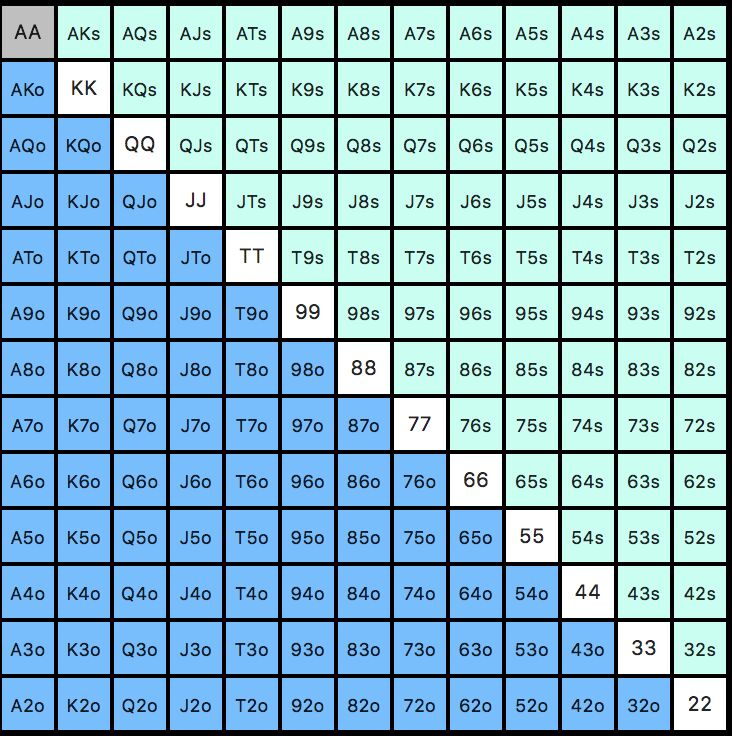
What is a Poker Range?
A poker range shows all the hands a player could have at a specific time. The upper right side contains suited hands, while the lower left has off-suit hands. Pocket pairs run diagonally down the middle. There are 169 hands players can be dealt in Texas Hold ’em and they all fit into a multi-colored grid, like the one shown below.
Solid or highlighted squares are included in the range and faded squares are excluded.
A player’s range changes depending on actions, like betting, checking, and raising.
Let’s do a simple example to understand the basics of poker ranges.
You’ve just been dealt your cards and the action begins. Before it’s your turn, a player ahead of you makes a small raise. The good news is, you’ve got a strong hand. You look down and see Ace-King of hearts.
Since your opponent made a preflop raise, you already have some information to help you build a range. For our example, let’s assume they are raising a typical range of hands, which you can see below.
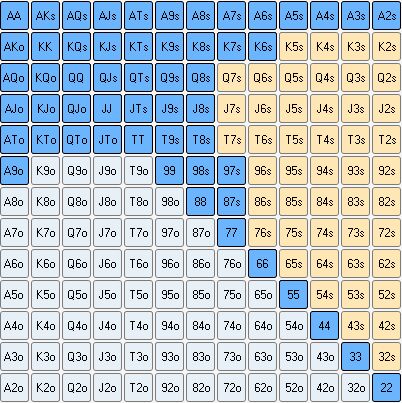
You feel that Ace-King suited is strong enough to re-raise (3-bet) your opponent, so you count out some chips and slide them across the table.
Instead of folding or calling your 3-bet, your opponent thinks for a moment and makes another raise (4-bet).
What can your opponent have? More specifically, what is the range of hands your opponent would 4-bet with?
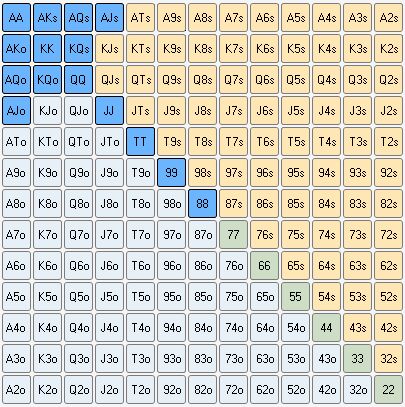
An amateur poker player thinks...
“My opponent has 4-bet me, so they must have a premium hand like pocket aces or pocket kings. It could be a bluff, but I don’t know what it cards they might bluff with.”
An experienced poker player thinks…
“My opponent has 4-bet me after making a preflop raise. Their range included lots of hands when they raised preflop, but their 4-bet range is much smaller. It includes premium pocket pairs like AA, KK, QQ, JJ, and some Broadway hands like AK, AQ, AJ, and so on. The range could include some smaller pocket pairs that prefer to raise, rather than call or fold.”
Remember that each opponent is different, so don’t always apply the same range to each player. GGPoker gives you a statistic tracker for your opponent, which is valuable when you are building ranges. This is a fantastic poker site to get more familiar with ranges since the GGPoker application comes with its own built-in heads-up display (HUD).
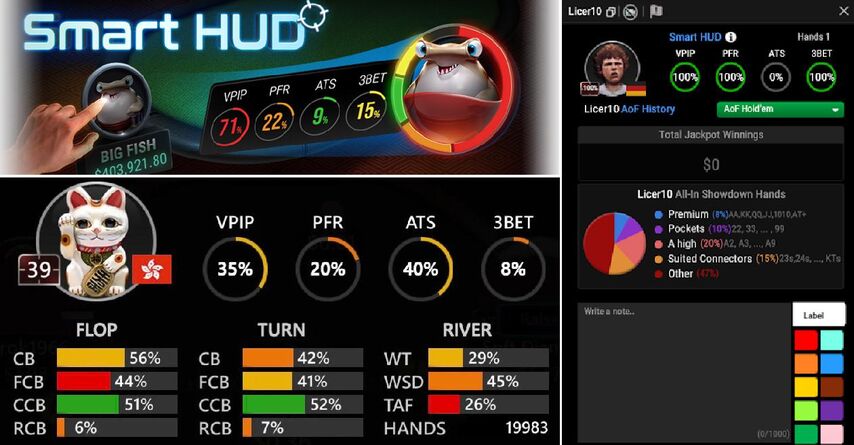
At the table, see useful information like:
- How often your opponent puts money in the pot (VPIP).
- How often your opponent raises preflop.
- How often they make continuation bets on the flop after a preflop raise.
- How often they fold to continuation bets (the bet that comes after a preflop raise).
- Tournament history and results
We also have HUDs for other popular poker sites. You can get a free trial for some heads-up display software, like Hand2Note, which is compatible with PokerStars. You’ll quickly see the advantage of having all information about your opponents in front of you at the table.
How to Build a Range in Poker
If you want to give your opponent a range, you need to estimate how many hands they are playing in a given situation. Are they playing lots of hands (loose) or just the strongest ones (tight)?
When you’re building ranges, you need to consider several factors, like:
- The action your opponent takes (checking/betting/raising/etc).
- Your opponent’s position at the table.
- The kind of player your opponent is.
It’s impossible to say with 100% certainty that your opponent will stick to the range you build for them. Experienced players sometimes play similar ranges in routine situations, but there are always going to be deviations.
More experienced poker players create and adjust their own charts, but you can find range charts pre-built by professional players.
When you’re playing at a casino or an online poker site, you won’t have a chance to construct a chart and make adjustments. Range charts are best used for self-studying after you’re finished playing.
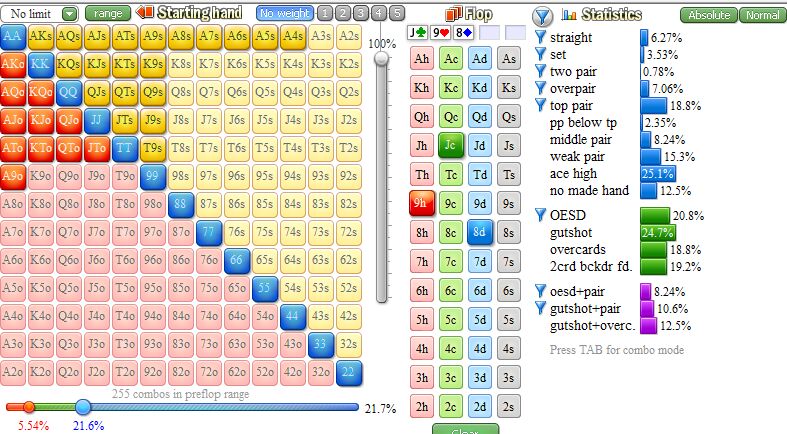
Flopzilla is an interactive range analysis tool you can use to show how different ranges connect with community cards. You can use the pre-loaded range charts and customize them easily for different opponents. There’s a lot of useful information this tool gives poker players, so Flopzilla is sure to improve your game. You can pick up a free trial in the GipsyTeam Shop or check out other range analysis tools.
How to Use Ranges in Poker
After you’ve gotten familiar with ranges, you can begin to use them to your advantage. Determining the hands your opponents could have is a massive advantage and a key to maximizing your win rate.
Exploiting players with narrow or tight ranges: Sometimes you’ll find that your opponents have a “tight” style, meaning that they prefer to play stronger hands with more equity. Tight opponents tend to fold too often, so you can widen your range and play more aggressively against them to win.
Exploiting players with wide or loose ranges: Most online poker sites are full of recreational players at micro and low-stakes tables. Sometimes, they can be quite loose and play a much wider range of hands than they should. When you’ve found an opponent who plays a wide range of hands, you can tighten up your own range and play stronger hands. You’ll be able to get value from their weaker range and mix bluffs into your range, taking advantage of your tight image.
Range analysis programs like Flopzilla will get you started, but poker courses and coaching could teach you faster. If you’re interested in other tools for studying ranges or you’d like to know more about poker solvers, start a no-obligation Live Chat with our experienced staff members.
- Increased rakeback and personal bonuses
- Help with deposits and cashouts
- Access to mobile applications
- Solving problems with accounts
- Technical support
- Questions about the site and forum























